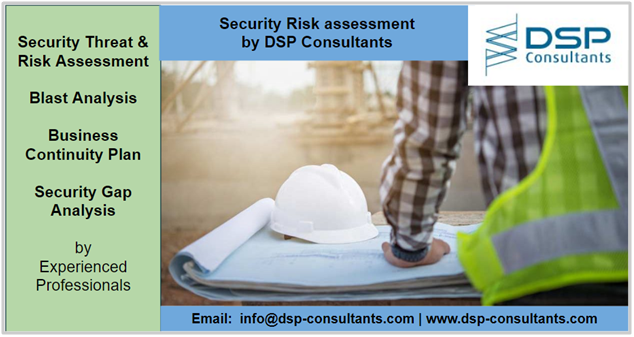Security Risk Assessment is the identification & analysis of security risks, followed by implementation of controls wherever necessary, to prevent threats, vulnerabilities & further amplification of security defects. We at DSP Consultants follow a thorough procedure in our Security Risk Assessment studies, a summary of which is given below –

1. Asset Characterization & Identification
Identifying which assets are at risk is the first step of any risk assessment study. This is the foundation of criticality & consequence analyses. What further helps determine possible consequences when assets are jeopardized, are probability & vulnerability analysis and risk analysis itself. These studies are vital to the mission of every organization.
2. Analyzing Risk Factors
We believe in asking the right questions in this phase: What is the scope of this risk assessment study? Does it meet the organization’s risk assessment objectives? Does it consider the requirements of the organization? This scope should encompass the processes, functions, physical boundaries (locations) and stakeholders of the organization, within the risk assessment study. We ensure the scope is in line with the resources available.
3. Mitigation of Risk (including Vulnerability Assessment)
Impact scales of risks measured during the security risk analysis should coincide with organizational scope & objectives. An impact on an organization may be financial, personal, reputation, etc. Hence, it is important to evaluate physical and operational security measures against evaluated risks and threats in order to identify security vulnerabilities in an organization and reduce the gap.
4. Organizational Resilience
An organizational-resilience approach to managing risk encourages businesses with critical infrastructure to develop a natural ability to curb unexpected disruptions. DSP Consultants aims to discover the most effective ways to achieve resilience, that allow the organization to adapt itself to changes in its respective operating environment over time. This is the end goal of all our security risk assessment studies.
5. Document Control and Assurance
Once the security risk assessment & risk analysis is complete, the final step is bringing the organization’s individual residual risk ratings together into a portfolio view. This helps the management undertake necessary actions to revise its risk responses and address the design & effectiveness of controls.
In conclusion, a security risk assessment program allows an organization to view itself from an attacker’s perspective. An accurate risk analysis supports management in making informed resource allocation, tooling, and security control implementation decisions. Thus, conducting a routine risk assessment is an integral part of an organization’s risk management process.







